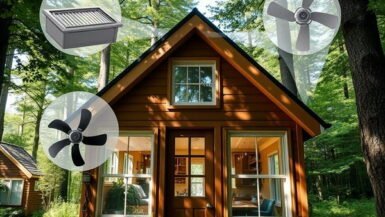In an era where environmental conservation and sustainable living are becoming increasingly important, the concept of tiny homes has gained significant traction. However, the true potential of these compact dwellings lies in their ability to function off-grid, harnessing renewable energy sources for power. In this article, we delve into the world of off-grid living, exploring the various options available for powering your tiny home with clean, renewable energy. From solar panels and wind turbines to micro-hydro systems and biofuels, we will guide you through the various methods to achieve energy independence, reduce your ecological footprint, and create a self-sustaining, eco-friendly living space without compromising on comfort or functionality. Join us as we embark on this enlightening journey towards a greener, more sustainable future.
Harnessing Solar Energy: Installing Photovoltaic Panels on Your Tiny Home
Solar power is a popular choice for those looking to power their tiny homes with clean, renewable energy. Photovoltaic (PV) panels offer an accessible and relatively low-maintenance solution for generating electricity from sunlight. In this section, we discuss the ins and outs of installing solar panels on your tiny home, as well as how to optimize your setup for maximum efficiency and reliability.
Choosing the Right Solar Panels for Your Tiny Home
There are various types of solar panels available on the market, but the most common and practical choice for tiny homes are monocrystalline and polycrystalline panels. Monocrystalline panels are known for their efficiency and durability, while polycrystalline panels tend to be more affordable. When selecting panels, it’s essential to consider factors such as available roof space, power needs, and budget. Additionally, it’s crucial to research the efficiency and warranty offered by the panel manufacturer.
Optimizing Your Solar Panel System
To get the most out of your solar panel system, you’ll need to ensure proper installation and positioning. Ideally, the panels should be installed at an angle that maximizes their exposure to sunlight throughout the day. In most cases, this means facing them south in the Northern Hemisphere or north in the Southern Hemisphere. Additionally, it’s essential to avoid shading from trees, buildings, or other obstructions.
Integrating Solar Power with Your Tiny Home’s Electrical System
Once you have chosen and installed the appropriate solar panels for your tiny home, it’s time to integrate them with your existing electrical system. This process typically involves connecting the panels to a charge controller, which regulates the flow of electricity to prevent overcharging or damage to your batteries. From there, the energy is stored in a battery bank, which can then be used to power your appliances, lighting, and other electrical needs.
Maintaining Your Solar Panel System
While solar panels are generally low-maintenance, regular care can help prolong their lifespan and ensure optimal performance. This includes periodic cleaning of the panels to remove dust and debris, as well as monitoring for any signs of damage or wear. Additionally, it’s important to keep an eye on your battery bank, ensuring that it remains in good condition and is adequately sized to meet your energy storage needs.
Incorporating solar power into your tiny home’s energy system is an excellent way to achieve off-grid living, reduce your ecological footprint, and enjoy the benefits of clean, renewable energy. By carefully selecting the right panels, optimizing their placement, and integrating them with your existing electrical system, you can create a sustainable, self-sufficient living space that is both comfortable and eco-friendly.
Utilizing Wind Power: The Benefits of Small Wind Turbines for Off-Grid Living
Embracing wind power as a source of renewable energy for your tiny home allows you to harness the power of nature, providing an environmentally friendly and cost-effective solution for off-grid living. In this section, we explore the benefits of small wind turbines and how they can be integrated into your tiny home’s energy system. We will discuss the different types of turbines available, how to choose the right one for your needs, and tips for installation and maintenance.
Types of Small Wind Turbines and Their Applications
Small wind turbines come in a variety of designs, each suitable for different applications and environments. The two most common types are horizontal-axis wind turbines (HAWTs) and vertical-axis wind turbines (VAWTs). HAWTs resemble traditional windmills, with blades that rotate around a horizontal axis, while VAWTs have blades that rotate around a vertical axis.
HAWTs are generally more efficient and can generate more power but may require a taller tower to capture stronger winds. In contrast, VAWTs can operate in lower wind speeds and turbulent conditions, making them ideal for urban or residential settings. It’s essential to evaluate your site’s wind conditions and your energy needs when choosing between these two types of turbines.
Choosing the Right Wind Turbine for Your Tiny Home
Selecting the appropriate wind turbine for your tiny home requires considering factors such as your energy needs, budget, and available space. Assess your daily energy consumption to determine the required turbine size to meet your demands. It’s also crucial to evaluate the average wind speeds in your location to ensure the turbine will operate efficiently. Additionally, consider any zoning restrictions, permits, and noise regulations in your area before making a decision.
Installation Tips for Optimal Performance
Proper installation is key to maximizing the efficiency and performance of your small wind turbine. Ensure that the turbine is mounted on a sturdy tower or pole, high enough to capture consistent wind flow. Avoid obstructions like trees, buildings, or terrain that may cause turbulence, as this can negatively impact the turbine’s performance. Also, consider the proximity to your tiny home and the length of the cable connecting the turbine to your electrical system, as this may affect energy transmission efficiency.
Maintaining Your Small Wind Turbine
Routine maintenance is essential to prolong the lifespan of your wind turbine and ensure its optimal performance. Regularly inspect the blades for damage or wear and lubricate moving parts as needed. Additionally, monitor the turbine’s output and perform any necessary repairs promptly. By staying proactive with maintenance, you can prevent potential issues and maximize the efficiency of your renewable energy system.
Utilizing wind power through small wind turbines offers numerous benefits for off-grid living in a tiny home. By understanding the available options, selecting the right turbine, and following proper installation and maintenance practices, you can enjoy a reliable, eco-friendly energy source that contributes to a sustainable, self-sufficient lifestyle.
Micro-Hydro Systems: Generating Electricity from Nearby Water Sources
For those fortunate enough to have access to a nearby water source, micro-hydro systems present an exciting opportunity to generate electricity for your tiny home. These systems harness the power of flowing water to produce clean, renewable energy with minimal environmental impact. In this section, we will explore the fundamentals of micro-hydro systems, including the principles behind their operation, the different types of systems available, and tips for selecting, installing, and maintaining a micro-hydro system for your off-grid tiny home.
Understanding the Basics: How Micro-Hydro Systems Work
At its core, a micro-hydro system captures the kinetic energy of flowing water and converts it into electricity. This process typically involves diverting a portion of the water through a pipeline, known as a penstock, which carries it to a turbine. As the water flows through the turbine, it spins a generator, producing electricity that can be used to power your tiny home.
The amount of electricity generated by a micro-hydro system depends on two primary factors: the flow rate of the water and the vertical drop, or head, between the intake and the turbine. The greater the flow rate and head, the more power the system can produce.
Types of Micro-Hydro Systems: Choosing the Right One for Your Tiny Home
Micro-hydro systems come in various configurations, each suited to different environments and needs. Some of the most common types include:
1. Impulse Turbines: These systems utilize high-pressure water jets to strike the turbine blades, causing them to spin and generate electricity. Impulse turbines are particularly well-suited for environments with high head and relatively low flow rates.
2. Reaction Turbines: In contrast to impulse turbines, reaction turbines generate electricity by utilizing the pressure and flow of the water as it passes through the turbine. These systems are more suitable for locations with lower head and higher flow rates.
3. Crossflow Turbines: These turbines feature a unique design that allows water to flow through the turbine blades multiple times, maximizing efficiency. Crossflow turbines are versatile and can work well in various environments, including those with moderate head and flow rates.
The best micro-hydro system for your tiny home will depend on your site’s specific conditions and your energy needs. Be sure to consult with a professional to assess your location and determine the most appropriate system for your situation.
Installation Tips for a Successful Micro-Hydro System
Proper installation is crucial for the effectiveness and longevity of your micro-hydro system. Key factors to consider during installation include:
1. Intake Location: Select a suitable location for your intake, ensuring that it will provide a consistent water supply and minimize the risk of debris clogging the system.
2. Penstock Design: The penstock’s size and material should be carefully chosen to minimize friction losses and ensure efficient water flow.
3. Turbine Placement: Position the turbine and generator in a secure, accessible location that allows for easy maintenance and monitoring.
4. Energy Storage: Incorporate a battery bank to store excess electricity for use during periods of low water flow or high demand.
Maintaining Your Micro-Hydro System for Optimal Performance
Regular maintenance is essential to ensure the reliable operation of your micro-hydro system. Key maintenance tasks include:
1. Inspecting the intake and penstock for leaks, debris, or damage and making necessary repairs.
2. Cleaning and lubricating the turbine and generator to prevent excessive wear and ensure smooth operation.
3. Monitoring the system’s output and overall performance to identify any potential issues promptly.
By implementing a micro-hydro system for your tiny home, you can tap into the power of flowing water to generate clean, renewable energy for off-grid living. With a thorough understanding of the principles, types, and operational aspects of micro-hydro systems, you can select and maintain an efficient, reliable system that meets your energy needs and contributes to a sustainable lifestyle.
Energy Storage Solutions: Choosing the Right Batteries for Your Renewable Energy System
Integrating renewable energy sources like solar, wind, or micro-hydro into your tiny home’s power supply is a significant step toward off-grid living. However, to ensure a consistent and reliable flow of electricity, you need an efficient energy storage solution. In this section, we discuss the importance of selecting the right batteries for your renewable energy system, the various types of batteries available, and how to maintain them for optimal performance and longevity.
Finding the Perfect Match: Factors to Consider When Choosing Batteries
Several factors need to be considered when selecting batteries for your renewable energy system, including:
1. Capacity: The battery capacity, measured in amp-hours (Ah), determines how much energy the battery can store. Consider your tiny home’s daily energy consumption and choose a battery with sufficient capacity to meet your needs.
2. Depth of Discharge (DoD): This refers to the percentage of a battery’s capacity that can be discharged before it needs to be recharged. Higher DoD batteries allow for more usable energy and may require fewer batteries in your system.
3. Cycle Life: The number of charge and discharge cycles a battery can undergo before its capacity is significantly reduced. Opt for a battery with a longer cycle life to avoid frequent replacements.
4. Cost: Consider both the initial investment and the long-term costs associated with the battery, such as maintenance and replacement expenses.
Types of Batteries for Renewable Energy Systems: Pros and Cons
Several types of batteries can be used in renewable energy systems, each with its pros and cons. Some of the most common options include:
1. Lead-Acid Batteries: A popular choice due to their affordability and widespread availability, lead-acid batteries come in two main types – flooded (or wet cell) and sealed (AGM or gel). While flooded batteries are more affordable, they require regular maintenance and are sensitive to temperature fluctuations. Sealed lead-acid batteries are more expensive, but they are maintenance-free and more resistant to temperature changes.
2. Lithium-Ion Batteries: These batteries are known for their high energy density, long cycle life, and low maintenance requirements. However, they are more expensive than lead-acid batteries and may require additional safety precautions.
3. Nickel-Iron Batteries: Offering exceptional durability and a long lifespan, nickel-iron batteries can withstand deep discharges and extreme temperatures. However, they have a lower energy density and are relatively expensive compared to other options.
Optimizing Battery Performance: Maintenance and Monitoring Tips
Proper maintenance and monitoring can significantly impact your battery’s performance and lifespan in your renewable energy system. Here are some tips to keep your batteries in optimal condition:
1. Regular Inspection: Periodically inspect your batteries for visible signs of damage, corrosion, or leaks. For flooded lead-acid batteries, check the electrolyte levels and top them up with distilled water as needed.
2. Temperature Control: Batteries can be sensitive to temperature fluctuations, so try to keep them in a well-ventilated, insulated space to maintain stable temperatures.
3. Charge Management: Ensure that your charge controller is properly configured to prevent overcharging or undercharging, which can negatively impact battery performance and lifespan.
4. Monitoring: Regularly monitor your batteries’ voltage, state of charge, and overall performance to identify any potential issues early on and address them promptly.
By carefully selecting the right batteries for your renewable energy system and maintaining them properly, you can enjoy a consistent, reliable power supply for your off-grid tiny home. This not only contributes to a sustainable and self-sufficient lifestyle but also ensures that you can fully harness the benefits of renewable energy sources.
Efficient Energy Use: Tips for Maximizing Your Tiny Home’s Renewable Energy Potential
As you embrace the concept of off-grid living and invest in renewable energy sources for your tiny home, it’s crucial to optimize your energy use to ensure maximum efficiency and sustainability. In this section, we share practical tips and strategies for making the most of your renewable energy systems, minimizing waste, and creating an energy-conscious, eco-friendly living space.
Implementing Energy-Saving Strategies: Small Changes, Big Impact
The first step in maximizing your tiny home’s renewable energy potential involves adopting energy-saving habits and implementing changes to your daily routine. Some examples include:
1. Turning off lights and appliances when not in use.
2. Using energy-efficient LED lighting options.
3. Unplugging electronics and chargers when not in use to avoid phantom power consumption.
4. Investing in energy-efficient appliances and devices, such as Energy Star-rated products.
5. Utilizing natural daylight and ventilation to reduce the need for artificial lighting and cooling systems.
By incorporating these simple practices into your daily life, you can significantly reduce your energy consumption and make the most of the renewable energy generated by your tiny home’s systems.
Optimizing Your Tiny Home’s Insulation: Minimize Heat Loss and Gain
Proper insulation is crucial for maintaining a comfortable living environment while reducing the energy demands of your heating and cooling systems. Key considerations for optimizing insulation in your tiny home include:
1. Selecting high-quality insulation materials, such as spray foam, mineral wool, or rigid foam boards, based on your climate and needs.
2. Ensuring proper installation techniques to avoid gaps or inconsistencies in the insulation layer.
3. Implementing air sealing measures to prevent drafts and air leaks.
4. Installing energy-efficient windows and doors, such as double or triple-pane windows with low-E coatings, to minimize heat transfer.
By investing in proper insulation and air sealing, you can minimize the burden on your renewable energy systems and maintain a comfortable, energy-efficient living space.
Smart Home Automation: Harnessing Technology for Energy Efficiency
Incorporating smart home automation technology into your tiny home can help you monitor and control your energy consumption more effectively. Some smart home features that can enhance your renewable energy system’s efficiency include:
1. Smart thermostats that learn your schedule and preferences, enabling efficient heating and cooling control.
2. Energy monitoring systems that track your energy consumption patterns and provide insights for improvement.
3. Smart lighting controls, such as dimmers, motion sensors, and timers, to optimize your lighting usage.
4. Integration of your renewable energy systems with a smart home hub for centralized control and monitoring.
Harnessing the power of smart home automation not only enhances the efficiency of your renewable energy systems but also allows you to enjoy a more convenient, connected living experience.
Regular System Maintenance: Ensuring Optimal Performance
Lastly, it’s essential to maintain your renewable energy systems and appliances regularly to ensure peak performance and longevity. This includes routine inspections, cleaning, and servicing of your solar panels, wind turbines, or micro-hydro systems, as well as regular maintenance of your batteries and other electrical components. By staying proactive with maintenance, you can prevent potential issues, optimize efficiency, and maximize the return on your investment in renewable energy.
In conclusion, maximizing your tiny home’s renewable energy potential involves a combination of energy-saving strategies, insulation optimization, smart home automation, and regular system maintenance. By adopting these practices and continuously seeking ways to improve your energy efficiency, you can create a sustainable, self-sufficient living space that showcases the true potential of off-grid tiny home living.





Leave a reply